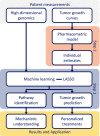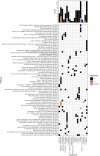Identification of high-dimensional omics-derived predictors for tumor growth dynamics using machine learning and pharmacometric modeling
- PMID: 33792207
- PMCID: PMC8099445
- DOI: 10.1002/psp4.12603
Identification of high-dimensional omics-derived predictors for tumor growth dynamics using machine learning and pharmacometric modeling
Abstract
Pharmacometric modeling can capture tumor growth inhibition (TGI) dynamics and variability. These approaches do not usually consider covariates in high-dimensional settings, whereas high-dimensional molecular profiling technologies ("omics") are being increasingly considered for prediction of anticancer drug treatment response. Machine learning (ML) approaches have been applied to identify high-dimensional omics predictors for treatment outcome. Here, we aimed to combine TGI modeling and ML approaches for two distinct aims: omics-based prediction of tumor growth profiles and identification of pathways associated with treatment response and resistance. We propose a two-step approach combining ML using least absolute shrinkage and selection operator (LASSO) regression with pharmacometric modeling. We demonstrate our workflow using a previously published dataset consisting of 4706 tumor growth profiles of patient-derived xenograft (PDX) models treated with a variety of mono- and combination regimens. Pharmacometric TGI models were fit to the tumor growth profiles. The obtained empirical Bayes estimates-derived TGI parameter values were regressed using the LASSO on high-dimensional genomic copy number variation data, which contained over 20,000 variables. The predictive model was able to decrease median prediction error by 4% as compared with a model without any genomic information. A total of 74 pathways were identified as related to treatment response or resistance development by LASSO, of which part was verified by literature. In conclusion, we demonstrate how the combined use of ML and pharmacometric modeling can be used to gain pharmacological understanding in genomic factors driving variation in treatment response.
© 2021 The Authors CPT: Pharmacometrics & Systems Pharmacology published by Wiley Periodicals LLC on behalf of American Society for Clinical Pharmacology and Therapeutics.
Conflict of interest statement
The authors declare no conflict of interest.
Figures





Similar articles
-
Translational pharmacokinetic-pharmacodynamic modeling from nonclinical to clinical development: a case study of anticancer drug, crizotinib.AAPS J. 2013 Apr;15(2):354-66. doi: 10.1208/s12248-012-9436-4. Epub 2012 Dec 19. AAPS J. 2013. PMID: 23250669 Free PMC article.
-
Application of Pharmacometric Analysis in the Design of Clinical Pharmacology Studies for Biosimilar Development.AAPS J. 2018 Mar 7;20(2):40. doi: 10.1208/s12248-018-0196-7. AAPS J. 2018. PMID: 29516330
-
Lifespan based pharmacokinetic-pharmacodynamic model of tumor growth inhibition by anticancer therapeutics.PLoS One. 2014 Oct 21;9(10):e109747. doi: 10.1371/journal.pone.0109747. eCollection 2014. PLoS One. 2014. PMID: 25333487 Free PMC article.
-
Integrated modeling of biomarkers, survival and safety in clinical oncology drug development.Adv Drug Deliv Rev. 2025 Jan;216:115476. doi: 10.1016/j.addr.2024.115476. Epub 2024 Nov 20. Adv Drug Deliv Rev. 2025. PMID: 39577694 Review.
-
Data-driven modeling and prediction of blood glucose dynamics: Machine learning applications in type 1 diabetes.Artif Intell Med. 2019 Jul;98:109-134. doi: 10.1016/j.artmed.2019.07.007. Epub 2019 Jul 26. Artif Intell Med. 2019. PMID: 31383477 Review.
Cited by
-
Contribution of machine learning to tumor growth inhibition modeling for hepatocellular carcinoma patients under Roblitinib (FGF401) drug treatment.CPT Pharmacometrics Syst Pharmacol. 2022 Aug;11(8):1122-1134. doi: 10.1002/psp4.12831. Epub 2022 Jun 21. CPT Pharmacometrics Syst Pharmacol. 2022. PMID: 35728123 Free PMC article. Clinical Trial.
-
Adoption of Machine Learning in Pharmacometrics: An Overview of Recent Implementations and Their Considerations.Pharmaceutics. 2022 Aug 29;14(9):1814. doi: 10.3390/pharmaceutics14091814. Pharmaceutics. 2022. PMID: 36145562 Free PMC article.
References
-
- Rodriguez‐Brenes IA, Komarova NL, Wodarz D. Tumor growth dynamics: Insights into evolutionary processes. Trends Ecol Evol. 2013;28:597‐604. - PubMed
-
- Claret L, Girard P, Hoff PM, et al. Model‐based prediction of phase III overall survival in colorectal cancer on the basis of phase II tumor dynamics. J Clin Oncol. 2009;27:4103‐4108. - PubMed
MeSH terms
Substances
LinkOut - more resources
Full Text Sources
Other Literature Sources
Medical

